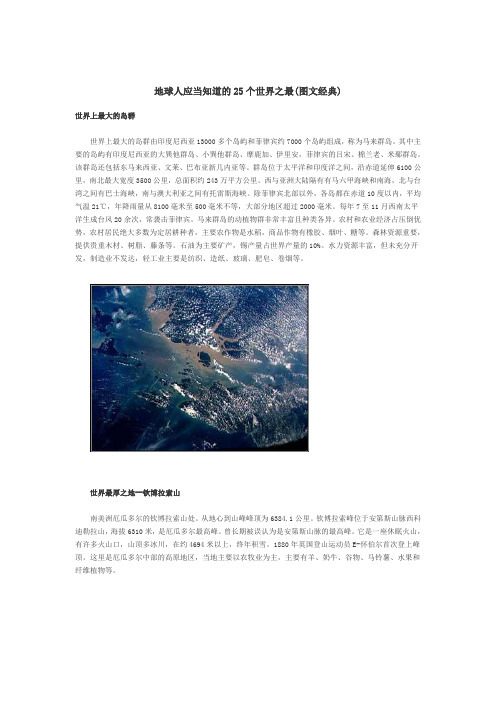撒哈拉沙漠卫星图分析
世界最大的沙漠--撒哈拉沙漠

世界最大的沙漠--撒哈拉沙漠撒哈拉沙漠(SaharaDesert),横贯非洲大陆北部,东西长达5600公里,南北宽约1600公里,总面积约9,065,000平方公里,约占非洲总面积撒哈拉大沙漠32%。
是世界上阳光最多面积最大的沙漠。
下面大家一起来看看这世界最大的沙漠:哈拉沙漠是世界上最大的沙漠,但这并不是她最初的面目。
在沙石遍布的撒哈拉不但有巧夺天工的自然景观,更有顽强的生命存在。
如果不是亲眼看见了栩栩如生,形态各异的壁画群,人们很难想象在这样恶劣的环境曾有过繁荣昌盛的远古文明。
撒哈拉沙漠位于非洲大陆的北部,是世界上除南极洲之外最大的荒漠,大约形成于250万年以前。
“撒哈拉” 一名来源于阿拉伯语,是从当地游牧民族——图阿雷格人的语言引入的,意思是“大荒漠”。
撒哈拉沙漠西临大西洋海岸,东抵红海之滨,北起阿特拉斯山脉,南至苏丹。
东西约为5600千米,南北纵贯1500—2000 千米,并且横跨摩洛哥、阿尔及利亚、突尼斯、利比亚、埃及、毛里塔尼亚、马里、尼日利亚、乍得、苏丹等国国境。
撒哈拉沙漠是世界上最大的沙漠,面积约960万平方千米,几乎占了整个非洲大陆面积的三分之一。
撒哈拉地区地广人稀, 平均每平方千米不足1人。
以阿拉伯人为主,其次是柏尔人等。
居民和农业生产主要分布在尼罗河谷地和绿洲,部分以游牧为主。
20世纪50年代以来,沙漠中陆续发现丰富的石油、天然气、铀、铁、锰、磷酸盐等矿,改变了该地区一些国家的经济面貌。
撒哈拉沙漠共分为西撒哈拉、中部高原山地和东部荒凉地区三部分。
中部高原山地包括位于阿尔及利亚的阿哈加尔高原,位于尼日尔的艾尔高原和位于乍得的提贝斯提高原,而撒哈拉沙漠的最高点就位于提贝斯提高原中的库西山,海拔为3415米;东部为特内雷沙漠和利比亚沙漠。
撒哈拉沙漠将非洲大陆分割成两部分——北非和南部黑非洲。
这两部分的气候和文化截然不同,南部边界是半干旱的热带稀树草原,阿拉伯语称为“萨赫勒”,再往南就是雨水充沛,植物繁茂的南部非洲,阿拉伯语称为“苏丹”,意思是黑非洲。
撒哈拉沙漠ppt课件

15
三毛迷恋自然,她被自然的活力和灵作深深吸引。广袤无垠的撒哈拉大沙漠 “属于她前世回忆似的乡愁”,是她“多年来梦中的情人”,撒哈拉的荒凉、炎 热、贫困、愚昧。但在三毛眼里,这里蔚蓝的天空,骆驼优雅的慢行,居民的淳 朴以及未知的一切都更强烈地是她有了栖息的感受。三毛之所以能在撒哈拉生活 下去,是她热爱着这片远离城市喧嚣,给她心灵满足的沙漠。对她而言,沙漠就 是新最好栖息的地方。
13
三毛与撒哈拉沙漠 三毛(1943年3月26日—1991年1月4日),原名陈懋平,又名陈平,汉族,
台湾著名女作家。一九四三年三月二十六日生,浙江省定海县人,中国文化大学哲 学系肄业。
曾留学欧洲,婚后定居西属撒哈拉沙漠迦纳利岛,并以当地的生活为背景,写 出一连串脍炙人口的作品。一九八一年回台后,曾在文化大学任教,一九八四年辞 去教职,而以写作、演讲为重心。
7
旅游攻略 撒哈拉旅游
原则上,赴撒哈拉的旅程可能和沙漠本身一样的变化多端,但是也有一些 经验之谈。首先要有组织的从一些沙漠门户城市进入,这些地方一般是绿洲, 也是撒哈拉沙漠文化的中心。在这里,所有的建筑是由自然孕育而成的,缓慢 的生活步调几个世纪也几乎没有改变。
8
若是不想局限于城镇,想要去周围旅游,也有两种方式。 第一:骑着骆驼穿越沙漠,创造横穿撒哈拉沙漠的传说。在这个骆驼的野生 动物园里,游客可以放慢步伐来适应撒哈拉的气候,欣赏沙漠中蕴含的细节 之美以及壮观的沙漠地形。 第二:四驱车探险,这种方式可以让你更加深入沙漠,甚至在你想去的景点 亲手扬起沙尘。 住宿:帐篷
撒哈拉沙漠“眼睛”之谜

撒哈拉沙漠“眼睛”之谜作者:来源:《小天使·六年级语数英综合》2020年第09期在撒哈拉沙漠这片荒无人烟的大荒漠里,隐藏着许多人类未知的秘密,其中,有一个地方被称为撒哈拉的“眼睛”,它更是充满了神秘和诡异的色彩。
宇航员的发现上世纪六十年代,美国一艘宇宙飞船在太空遨游,当飞船经过非洲上空时,宇航员在远离地球几百千米的天空,观察到了一个奇怪的现象:在撒哈拉沙漠的西南部,出现了一个圆形的东西,它像一只睁得圆溜溜的眼睛,紧紧地盯着太空。
撒哈拉沙漠从眼前消失后,宇航员仍然感到那只“眼睛”在紧紧地盯着他后背,令他有一种芒刺在背的感觉。
这只“眼睛”,就是被人们称为撒哈拉之眼的奇异地貌。
其实,很早以前,它就已经出现在撒哈拉西南部,并在荒凉、枯寂的沙漠里沉睡了若干年。
如果不是宇航员在太空“唤醒”了它,它可能还会长期沉睡下去。
神秘的撒哈拉之眼这只巨大的“眼睛”,位于撒哈拉西南部的毛里塔尼亚境内。
当人们来到这里之后,发现所谓的眼睛,其实是一个出现在沙漠地面上的巨大同心圆。
它的海拔高度大概在400米左右,过去,这里荒无人烟,即使有人偶然来到这里,也会“不识庐山真面目,只缘身在此山中”。
因为这个“同心圆”是如此之大,它的直径有50公里左右,置身其中,你根本不知道它是圆是方。
只有太空中的宇航员,或者天上的人造卫星才能一览它的全貌。
從卫星照片上看,这个“同心圆”实在太像一只眼睛了。
“同心图”一共分为三层,最中心的一个圆圈,很像一只眼珠,它的一侧边缘稍有破损,但并不妨碍它的美观。
这只“眼珠”的外围,是一个更大一些的圆圈,它把中心的圆圈紧紧包围起来,无可争议地成为了“眼瞳”。
最外围的那个大圈,当然便是“眼睑”了,更绝的是,这个大圈的外沿还有丝丝缕缕的环状物,它们仿佛是这只“眼睛”的眼睫毛。
撒哈拉之眼的内部十分平坦,四周则是一些浅山丘,再远处,便是漫漫黄沙了。
站在“眼睛”边上观察,撒哈拉之眼犹如山岩雕琢而成的大木盆,又像一只巨大的碟子。
八年级区域地理知识点之撒哈拉以南非洲

八年级区域地理知识点之撒哈拉以南非洲1、位置:撒哈拉以南的非洲位于世界上最大的沙漠-----撒哈拉沙漠以南,东临印度洋,西临大西洋,处于低纬度地区。
地形:由东南向西北倾斜,以高原为主。
(图8.26:印度洋、大西洋、埃塞俄比亚高原、东非高原、南非高原、刚果盆地、几内亚湾、撒哈拉沙漠、尼罗河、好望角、乞力马扎罗山—非洲最高峰,称为赤道雪峰)气候以热带草原气候为主,在热带草原地区的国家常受到旱灾的威胁。
本区90%以上是黑种人,是黑种人的故乡,故撒哈拉以南的非洲又有“黑非洲”之称。
非洲黑人的原始居住地主要分布在几内亚湾沿岸和刚果盆地,即主要分布在本区的西部。
2、“单一商品为主的经济”:●单一商品为主的经济:出口物品主要有矿产、森林、畜产等初级产品:进口物品为机械、汽车等工业制成品。
这样的经济特点使非洲许多国家失去了市场主动权。
①概念:过分依赖某一种或几种产品生产的经济;②弊端:初级产品价格低廉,工业制成品价格昂贵,制约了本国经济的发展;③形成原因:长期受到殖民主义者的统治和控制;④出路:发展多样化农业,振兴民族工业,建立出口加工区,发展旅游业,以改变本国经济依赖单一产品的局面。
3、严重的“人口、粮食与环境”问题:①人口问题②粮食问题③环境问题●非洲的`人口自然增长率在世界各大洲中居首位,(为2.2%,撒哈拉以南的非洲更高达3.0%),人口增长过快,超过粮食及经济增长速度,已构成了日益严重的人口问题和粮食问题。
由于殖民主义的长期统治和控制,本区科学技术落后,农牧业生产水平很低,粮食始终不能自给。
而人口增长过快,需要更多的粮食和肉类,于是人们砍伐森林,开垦草原,以扩大耕地面积,或过度放牧,导致土壤肥力下降、草原退化,加剧了土地荒漠化,使生态环境逐步恶化。
解决措施:控制人口数量;提高农牧业生产水平;保护自然环境。
●本区气候以热带气候为主,因此是很多热带经济作物的故乡,如咖啡、可可。
●本区很多矿产资源在世界中占有有重要地位,如金刚石、铜。
撒哈拉沙漠的前世今生:从繁荣绿洲到荒凉沙海的演变

撒哈拉沙漠的前世今生:从繁荣绿洲到荒凉沙海的演变撒哈拉沙漠的河流历史撒哈拉沙漠在地球上以其广袤的面积和极端的气候条件著称。
然而,这片如今的干旱之地曾经经历过显著的气候变化,曾经是充满生命的绿色区域。
在距今约10,000年至5,000年前的湿润期,撒哈拉沙漠是一个由丰富的河流、湖泊和湿地构成的生机勃勃的生态系统。
这些古代河流如同生命之源,滋养了当时的居民,并孕育了繁荣的文明。
通过对地质层的研究,科学家发现了沙漠中隐藏的古代河流遗迹。
这些遗迹包括干涸的河床、沉积的湖泊及水渠系统。
这些古老河流的存在证明了撒哈拉曾经的生态系统的复杂性和多样性。
古代河流的遗迹不仅反映了气候的变化,还揭示了当时水资源的分布与利用。
气候模型和沉积物分析表明,撒哈拉地区的气候在这一时期经历了从湿润到干旱的剧烈转变,这一变化对当地的生态系统和人类文明产生了深远的影响。
河流遗迹的发现与解读近年来,随着技术的发展,考古学家和地质学家们运用卫星遥感技术发现了更多撒哈拉沙漠中的古老河流遗迹。
卫星图像能够揭示地下的地形特征,包括古代河流的河道和沉积物。
这些技术帮助科学家们在广阔的沙漠中定位和分析河流遗迹,进而揭示了这些河流的历史和演变过程。
考古学家的现场勘探和挖掘也为这些遗迹提供了实物证据。
通过对沙漠遗址的考古发掘,研究人员发现了古代水渠、灌溉系统和湖泊沉积物。
这些遗迹显示了古代文明如何利用这些河流来支持农业生产和城市建设。
分析这些遗迹不仅帮助我们理解古代气候变化,还揭示了古代人类如何适应环境变化并利用水资源的智慧。
对这些遗迹的解读是理解古代撒哈拉文明的重要途径。
古老河流对文明的影响古代撒哈拉的河流对当地文明的发展具有深远的影响。
首先,河流提供了宝贵的水源,使得农业得以发展。
考古发现表明,古代撒哈拉地区的人们利用复杂的灌溉系统种植作物,维持了稳定的食物供应。
这些农业活动不仅促进了经济的发展,也为社会的繁荣提供了基础。
其次,河流的存在促进了文明的交流与融合。
七年级地理下册撒哈拉以南的非洲

第66页 活动题 人地关系的建议
饥饿的非洲难民
返 回
非洲的黑人居住区和外来移民
黑人主要分布在中部和南部 外来移民主要分布在北非和非洲东部及南部沿海地区
思 考
非洲黑人的原始居住地的自然环境有何特点
返 回
黑色人种
返 回
独特的非洲雕刻艺术
粗旷奔放的非洲绘画艺术
撒哈拉以南非洲特有的民族歌舞
死海
东非大裂谷卫星图片
东非大裂谷景观
埃塞俄比亚高原
南非高原
东非高原
撒 哈 拉 沙 漠
刚果盆地
乞力马扎罗山
对照地图仔细观察小鸟带领我们经过了哪些 地区这些地区有什么特点
大 西 洋
几内亚湾
莫桑比克海峡
印 度 洋
乞力马扎罗山景观
几内亚湾Gulf of Guinea
好望角Cape of Good Hope
主要国家:苏丹、尼日利亚、南非、埃塞俄比亚、赞比亚等
国家和 地区
非洲现有53个独立的国家在地理上习惯把非洲按地理方位分成北非、东非、南非、西非、中非五个部分
1
2
3
4
5
一、位置和ቤተ መጻሕፍቲ ባይዱ围
纬度位置:
绝大部分在南北回归线之间
经度位置:
200W——500E
海陆位置:撒哈拉沙漠以南 东临印度洋、西接大西洋
马达加斯加岛 (Madagascar)
印度洋 (Indian Ocean)
好望角
返 回
红海 (Red Sea)
大西洋(Atlantic Ocean)
尼日尔河
尼罗河
刚果河
赞比西河
三河流
三撒哈拉以南非洲的河流
初一地理(人教版)-撒哈拉以南的非洲-2PPT课件

咖啡、可可、椰枣、油棕、香 蕉,生物资源丰富。
读图,说出撒哈拉以南非洲国家出 口产品及其特点。
出口产品以初级农矿产品为主, 且出口产品比较单一
本区部分国家主要进口的产品和贸易伙伴
国家
主要进口产品
主要贸易活伙伴
加纳 博茨瓦纳 埃塞俄比亚
动物狂欢迁徙地
饥饿,不只因为蝗虫 你的未来将会更好
一袋咖啡豆引发的思考
图1是“非洲地图”,图2是“非洲沿南纬3°地形剖面图”。读图,回答
问题。
• 非洲
①地势东南高,西北低
②河流自东南向西北注入大西洋
③撒哈拉以南地区矿产资源丰富
④北部沙漠面积广大,气候干旱
A.①②③ B. ①②④ C. ①③④ D. ②③④
有人说在这里的人民正在挨饿,2020太难了……
饥饿,不只因为蝗虫 人口自然增长率高,人口快速增长。
世界各大洲或地区人口数(2010年)和平均人 口增长率(2005 ~ 2010年)
2005-2010年撒哈拉以 南非洲部分国家的平均
人口自然增长率图
饥饿,不只因为蝗虫
热带草原气候异常,受旱灾影响。 农牧业生产落后,产量低。
请根据撒哈拉以南非洲地形图,说出 该地区的地形特征,并指出动物迁徙 地的地形区。
①撒哈拉沙漠
②埃塞俄比亚高原 ③东非高原
高原为主
④南非高原 东南高、西北低
⑤刚果盆地
请根据撒哈拉以南非洲气候分布图, 说出该地区的气候特征,并试着解释 动物迁徙的原因。
热带气候为主 热带草原气候分布最广
请以乍得首都恩贾梅纳的气温曲线降水柱 状图为例,说一说热带草原气候的特点。
高中地理选择性必修一 试卷期末检测试卷(二)

期末检测试卷(二)(满分:100分)一、选择题(每小题2.5分,共50分)(2021·广东地理)据报道,北京时间2021年4月29日,包括我国搭载空间站天和核心舱的长征5号B等三枚运载火箭先后发射升空。
三个发射场均位于海岸线附近。
下表为三枚运载火箭发射的相关信息。
据此完成1~2题。
1.三枚火箭发射离开地球表面的先后顺序为()A.长征5号B、织女星、猎鹰9号B.长征5号B、猎鹰9号、织女星C.织女星、长征5号B、猎鹰9号D.织女星、猎鹰9号、长征5号B2.从纬度地带性角度考虑,三个发射场所在地自然带为亚热带常绿阔叶林带的个数为() A.0个B.1个C.2个D.3个答案 1.C 2.B解析第1题,对比三个时间早晚,只需统一换算成一个标准时间。
比如以我国长征5号B 发射时间为基准,是北京时间29日11:23,则欧洲织女星的发射时间为北京时间29日9:50,西五区的美国猎鹰9号于北京时间29日11:44发射,先后顺序依次是欧洲织女星、中国长征5号B、美国猎鹰9号,选C。
第2题,亚热带常绿阔叶林带对应的气候类型是亚热带季风气候和亚热带季风性湿润气候,海南文昌发射场位于热带地区,是热带季风气候;库鲁发射场位于南美洲东北部,是热带雨林气候;美国的卡纳维拉尔角位于墨西哥湾的佛罗里达半岛上,受墨西哥湾暖流增温增湿的影响,形成亚热带季风性湿润气候,对应的自然带为亚热带常绿阔叶林带,选B。
北京时间2021年5月5日14时47分迎来立夏节气。
据《逸周书·时训解》记载,立夏分三候:一候蝼蝈鸣,二候蚯蚓出,三候王瓜生。
立夏只是夏季的一个预告,并不意味着“入夏”。
气象学对于入夏有严格的标准,只有当一个地区连续5日的平均气温达到22 ℃以上时,才确定为夏季开始。
下表为不同节气太阳直射点的纬度。
据此完成3~5题。
节气春分清明谷雨立夏小满夏至太阳直射点纬度(°N) 0 5.85 11.32 / 20.07 23.433.下列有关立夏的说法,正确的是()A.南方地区正式进入夏季B.立夏一候约为15天C.立夏时美国西部为6日D.立夏时华北地区旱情严重4.立夏之后,民间有“立夏、小满,江满、河满”说法,此处“江、河”最可能是() A.淮河B.闽江C.嫩江D.汾河5.推测立夏时太阳直射点的纬度最可能是()A.14.37°B.15.37°C.16.37°D.17.37°答案 3.D 4.B 5.C解析第3题,由材料可知,立夏只是夏季的一个预告,并不意味着“入夏”,A错误;立夏到小满约15天,故一候约5天,B错误;北京时间2021年5月5日14时47分迎来立夏节气,此时美国西部时间(西八区),应为5月4日,C错误;立夏时,华北雨季还没来临,气温高,蒸发旺盛,旱情严重,D正确。
地球上最大的沙漠是哪个

地球上最大的沙漠是哪个当我们谈及地球上的沙漠,那广袤无垠的沙海景象总会在脑海中浮现。
在众多的沙漠之中,最大的当属撒哈拉沙漠。
撒哈拉沙漠位于非洲大陆北部,它的面积之大,让人难以想象。
其总面积约达 932 万平方千米,几乎占据了非洲大陆的三分之一。
这是一个怎样的概念呢?打个比方,如果把撒哈拉沙漠看作一个国家,那它的面积能在世界各国中名列前茅。
撒哈拉沙漠的气候极端干燥和炎热。
这里日照强烈,阳光几乎无遮无拦地倾泻而下,使得地面温度常常飙升到极高的程度。
年降水量稀少得可怜,有些地区甚至多年都滴雨未下。
在这样恶劣的气候条件下,生命的生存面临着巨大的挑战。
然而,尽管环境如此严酷,撒哈拉沙漠并非一片死寂。
在这片沙漠中,依然有着适应了极端环境的生物。
比如,骆驼被称为“沙漠之舟”,它们凭借着独特的生理结构和顽强的耐力,能够在沙漠中长途跋涉,为人们运输物资,成为了沙漠中重要的交通工具。
还有一些耐旱的植物,它们有着特殊的根系和水分储存机制,能够在短暂的降雨后迅速吸收水分,并在干旱时期依靠储存的水分存活。
撒哈拉沙漠的地形也是多种多样的。
有起伏的沙丘,这些沙丘在风的作用下不断移动和变形,形成了一幅幅如梦如幻的景象。
有的沙丘高达数百米,陡峭的坡面让人望而生畏。
除了沙丘,还有广阔的砾石平原和干涸的河谷。
这些不同的地形构成了撒哈拉沙漠独特而壮观的地貌。
在撒哈拉沙漠的历史长河中,它也曾经经历过气候变化和人类活动的影响。
在古代,这里或许并非像如今这般干旱,一些地区可能曾经有过繁荣的文明和丰富的生态。
但随着时间的推移,气候的变化和人类活动的加剧,使得这片土地逐渐变成了如今的模样。
对于人类来说,撒哈拉沙漠既是一个巨大的挑战,也是一个充满神秘和魅力的地方。
科学家们不断地对其进行研究,试图揭示它的形成机制、气候变化规律以及生态系统的奥秘。
同时,撒哈拉沙漠也吸引着众多勇敢的探险家,他们深入其中,探寻未知,感受大自然的伟大和人类的渺小。
随着现代科技的发展,我们对撒哈拉沙漠的了解越来越深入。
世界最大的沙漠-撒哈拉沙漠

世界最大的沙漠-撒哈拉沙漠利比亚西南部撒哈拉沙漠中的移动沙丘撒哈拉沙漠约形成于二百五十万年前,乃世界第二大荒漠,仅次于南极洲,是世界最大的沙质荒漠。
它位于非洲北部,气候条件非常恶劣,是地球上最不适合生物生存的地方之一。
其总面积约容得下整个美国本土。
“撒哈拉”是阿拉伯语的音译,源自当地游牧民族图阿雷格人的语言,原意即为“沙漠”。
目录简介自然特征地形水系土壤气候植物动物形成原因历史发展史前时期水牛时期黄牛时期马时期地貌类型组成部分环境气候居民经济研究和探索撒哈拉沙漠岩画穿越撒哈拉沙漠数千年前陨石坑展开简介自然特征地形水系土壤气候植物动物形成原因历史发展史前时期水牛时期黄牛时期马时期地貌类型组成部分环境气候居民经济研究和探索撒哈拉沙漠岩画穿越撒哈拉沙漠数千年前陨石坑撒哈拉沙漠(英文名为:Shr Desert)世界上阳光最多的地方,也是世界上最大和自然条件最为严酷的沙漠。
撒哈拉沙漠是世界最大的沙漠,几乎占满非洲北部全部,占全洲总面积的四分之一。
东西约长4,800公里(3000里),南北在1300至1900公里(800至1200里)之间,总面积约9065000平方公里。
撒哈拉沙漠西濒大西洋,北临阿特拉斯山脉和地中海,东为红海,南为萨赫勒一个半沙漠乾草原的过渡区。
撒哈拉沙漠是世界上除南极洲之外最大的荒漠,位于非洲北部,气候条件极其恶劣,是地球上最不适合生物生长的地方之一。
阿拉伯语撒哈拉意即“大荒漠”。
位于阿特拉斯山脉和地中海以南(约北纬35?线),约北纬14?线(250毫米等雨量线)以北,西起大西洋海岸,东到红海之滨。
横贯非洲大陆北部,东西长达5600公里,南北宽约1600公里,总面积约9,065,000平方公里,约占非洲总面积32%。
可以将整个美国本土装进去,“撒哈拉”这个名称来源于阿拉伯语لاصحراء,是从撒哈拉沙漠计划建造世界最大太阳能电厂当地游牧民族图阿雷格人的语言引入的,在其语言中就是“沙漠”的意思。
新高中地理高考专题14大气的运动(答案版)

专题14 大气的运动试卷副标题考试范围:xxx;考试时间:100分钟;命题人:xxx注意事项:1.答题前填写好自己的姓名、班级、考号等信息2.请将答案正确填写在答题卡上第I卷(选择题)请点击修改第I卷的文字说明一、单选题1.(2022·上海浦东新·一模)下图为澳大利亚年降水量分布图。
①、①两地降水集中的季节分别是当地的()A.夏季、冬季B.夏季、夏季C.冬季、夏季D.冬季、冬季(2022·河北·模拟预测)下图为某海湾地理要素分布图。
据此完成下列小题。
2.下列区域中盐度最高的是()A.加勒比海B.密西西比河口C.阿查法拉亚湾D.西佛罗里达大陆架所在海域3.若大范围控制亚欧大陆的某天气系统与图中涡流的旋转方向一致,则该天气系统最强盛的季节是()A.春季B.夏季C.秋季D.冬季4.(2022·上海长宁·一模)2021年8月10日开始,在长江中下游地区又重新出现闷热潮湿的雷雨、阵雨天气,并且维持相当一段时期。
造成这种“倒黄梅”天气出现的直接原因是()A.副热带高压增强B.副热带高压减弱南退C.北方冷空气强度偏弱D.暖湿气流移动速度较快(2022·全国·模拟预测)撒哈拉沙漠是全球最大的沙尘源之一,每年从这里吹出的沙尘超过1.8亿吨,这些沙尘随着强风影响多地。
2021年在撒哈拉沙尘暴活跃的时期,美国国家航空卫星在大西洋上空捕捉到了大量灰黄色的尘埃,哥白尼大气监测局监测到撒哈拉沙尘席卷了中东欧多个国家。
据此完成问题。
5.部分来自撒哈拉沙漠的沙尘可影响到挪威和瑞典南部,其传输路线可能是()A.西南季风—中纬上升—盛行西风—极地东风垂直下沉B.垂直上升—盛行西风—西北季风—极地东风垂直下沉C.垂直上升—高空西南风—垂直下沉—盛行西风—极地东风D.东北信风—赤道上升—高空西南风—副热带下沉—盛行西风6.大量沙尘飘落各处,会()A.减缓阿尔卑斯山积雪融化速度B.影响高空飞机飞行视线C.影响当地的光照和降水D.增大风力,增加风力发电量7.(2022·上海静安·一模)下图表示北半球大气环流状况的季节是()A.冬季B.春季C.秋季D.夏季8.(2022·上海奉贤·一模)对流层厚度因纬度和季节的不同而不同。
地球人应当知道的25个世界之最图文经典

地球人应当知道的25个世界之最(图文经典)世界上最大的岛群世界上最大的岛群由印度尼西亚13000多个岛屿和菲律宾约7000个岛屿组成,称为马来群岛。
其中主要的岛屿有印度尼西亚的大巽他群岛、小巽他群岛、摩鹿加、伊里安,菲律宾的吕宋、棉兰老、米鄢群岛。
该群岛还包括东马来西亚、文莱、巴布亚新几内亚等。
群岛位于太平洋和印度洋之间,沿赤道延伸6100公里,南北最大宽度3500公里,总面积约243万平方公里。
西与亚洲大陆隔有有马六甲海峡和南海,北与台湾之间有巴士海峡,南与澳大利亚之间有托雷斯海峡。
除菲律宾北部以外,各岛都在赤道10度以内,平均气温21℃,年降雨量从8100毫米至500毫米不等,大部分地区超过2000毫米。
每年7至11月西南太平洋生成台风20余次,常袭击菲律宾。
马来群岛的动植物群非常丰富且种类各异。
农村和农业经济占压倒优势,农村居民绝大多数为定居耕种者,主要农作物是水稻,商品作物有橡胶、烟叶、糖等。
森林资源重要,提供贵重木材、树脂、藤条等。
石油为主要矿产,锡产量占世界产量的10%。
水力资源丰富,但未充分开发,制造业不发达,轻工业主要是纺织、造纸、玻璃、肥皂、卷烟等。
世界最厚之地--钦博拉索山南美洲厄瓜多尔的钦博拉索山处。
从地心到山峰峰顶为6384.1公里。
钦博拉索峰位于安第斯山脉西科迪勒拉山,海拔6310米,是厄瓜多尔最高峰。
曾长期被误认为是安第斯山脉的最高峰。
它是一座休眠火山,有许多火山口,山顶多冰川,在约4694米以上,终年积雪。
1880年英国登山运动员E-怀伯尔首次登上峰顶。
这里是厄瓜多尔中部的高原地区,当地主要以农牧业为主,主要有羊、奶牛、谷物、马铃薯、水果和纤维植物等。
世界最高的高原--青藏高原青藏高原是中国最大的高原,也是世界上最高的高原,因此有"世界屋脊"之称。
青藏高原面积240万平方公里,海拔大多在3500米以上,包括西藏和青海的全部、四川西部、新疆南部及甘肃、云南的一部分。
地理作业设计案例一等奖

地理作业设计案例一等奖一、案例描述在这个地理作业设计案例中,我们将探讨世界上最大的沙漠——撒哈拉沙漠。
撒哈拉沙漠位于非洲北部,横跨阿尔及利亚、摩洛哥、西撒哈拉、利比亚、苏丹和乍得,面积约900万平方公里,是世界上最大的热带沙漠。
沙漠的气候条件极其恶劣,夏季炎热干燥,冬季寒冷,降雨极少。
由于其特殊的地理环境和气候条件,撒哈拉沙漠被誉为地球上最不适宜人类居住的地方之一。
二、案例内容1.沙漠的地理位置和地形特征首先,学生可以研究撒哈拉沙漠的地理位置和地形特征。
这包括沙漠的横跨国家,面积,地形特征(如沙丘、岩石地表等),以及对生态环境的影响等内容。
2.沙漠的气候特点其次,学生可以研究沙漠的气候特点,包括气温,降雨量,风向等。
学生可以通过收集数据和制作气候图表等方式,展现撒哈拉沙漠的极端气候条件。
3.对生态环境的影响撒哈拉沙漠的气候条件对生态环境产生了巨大的影响。
学生可以探究沙漠中的植被和动物,以及它们如何适应沙漠的恶劣环境。
同时,可以通过研究沙漠环境对当地民众的生活和生产的影响,让学生了解沙漠环境的重要性。
4.沙漠的变迁最后,学生可以研究撒哈拉沙漠的变迁过程。
借助地图、卫星影像等信息,学生可以了解沙漠的扩张和退缩的过程,以及这些变化对周边地区的影响。
三、案例目的本案例主要旨在通过学生自主收集资料,运用地理知识和技能,深入研究世界上最大的沙漠撒哈拉沙漠,从而加深对地理环境和自然地理现象的认识。
通过此次案例的学习,学生将能够更好地理解地球的自然现象,认识到地理环境对人类生活和社会发展的重要影响。
四、案例要求1.收集撒哈拉沙漠相关的地理信息和数据,并整理成综合报告。
2.利用地图、气象数据等制作气候图表,展现沙漠的气候特点。
3.通过研究沙漠的生态环境,探讨沙漠对当地居民和生物的影响。
4.细致研究沙漠的扩张和退缩的过程,分析对周边地区的影响。
五、案例评价标准1.能够全面整理和分析撒哈拉沙漠的地理信息,包括地理位置、地形特征、气候条件、生态环境等。
20张最壮观的卫星地球图片

1。
东非尼亚贡戈火山爆发东非尼亚贡戈火山爆发在非洲记录在案的火山爆发次数中,尼亚贡戈火山占到了20%。
它位于地球最大峡谷--东非大峡谷的边缘,后者从非洲中东部向南直至中部非洲绵延数千英里。
2。
青藏高原的纳木错湖青藏高原的纳木错湖位于青藏高原的高原湖--纳木错,是世界上最人迹罕至的地方之一。
该图由国际太空站一颗轨道卫星所摄,生动显示了冬季时纳木错湖的景象。
纳木错海拔16503英尺,约5030米,被认为水质超寡营养,因为无论在湖水还是湖底沉积物中营养物含量都极低,上图中显示了冬季湖面复杂壮观的冰块。
3。
阿拉伯半岛上的鲁布哈利阿拉伯半岛上的鲁布哈利这里又被称为阿拉伯半岛的不毛之地,是世界上最大的沙海,这里的含沙量占整个撒哈拉沙漠的一半,面积达58万3千平方公里,跨越沙特阿拉伯、也门和阿联酋数国的部分领土。
本图为不毛之地的高清放大图,由NASA第7号地球资源探测卫星摄于2001年8月26日。
4。
伊朗的沙漠伊朗的沙漠Dasht-e Kevir,又称沙漠谷,是伊朗境内最大的沙漠,原为无人居住的废弃地,由泥浆和盐沼组成,其表面的盐层可保护仅有的水分不会完全蒸发。
5。
南极洲南极洲即使是地球上冰雪覆盖最多的地方,南极洲也能发现几处未藏在雪层之下的土地。
本图显示的是在罗斯海和南极洲东部大冰层之间的一系列平行山谷,又称干谷,由于下沉风终年肆虐,来自高纬度又干又冷的气流会将冰雪吹下山坡,吹向海洋。
干谷还有大片冰川和冰封湖,本图是颜色校正的热成像图,由NASA的Terra卫星摄于2000年11月29日。
6。
韩国济州岛韩国济州岛椭圆状的济州岛位于朝鲜半岛南端,是一座典型的火山岛,面积1845平方公里(712平方英里)。
地质学家估计该岛形成于2百万年前,考古学者发现此处史前即有人类活动的迹象。
今天的济州岛既是著名的旅游胜地,也是联合国教科文组织指定的世界文化遗产之一。
7。
尼罗河沉积平原尼罗河沉积平原苏丹南部的卡图姆是白尼罗河和蓝尼罗河汇合之处,在此处的阿尔戈齐拉州形成了壮观的沉积平原。
TerraExplorer Pro v7.0用户操作手册-2019v1.0

4.1
启动界面 ......................................................................................................................... 13
4.2
界面布局 ......................................................................................................................... 13
3.1
TerraExplorer 7.0.1 版本新特性 .......................................................................................8
3.1.1 栅格图层改进 ............................................................................................................ 8
3.2.6 分析工具..................................................................................................................10
3.2.7 使用 SkylineGlobe Server– 发布工具 .....................................................................10
1.1
关于本手册 ....................................................................................................................... 1
纬度30度线之谜

颗 用整块水晶石镂刻成的、 与真人头盖 据专家估计 , 这颗水晶头盖骨至少有
据考证 ,这 宏伟壮观 的石柱群已 有
50 0 的 历 史 。 0 年
骨一模一样的玲珑剔透的水 晶头盖 骨。
科学家们惊诧不已 , 这是什么人制造
1 0万年的历史。那么 ,O万年前 , 玛雅 出这 巧 夺 天 工 的 杰作 呢? 些 人 是 用什 么 1 古 这 人又是怎 样把整块 坚硬的 天然水晶石加 方 法吊装石柱 的呢?这些 巨石又来 自何 工得如此精细 , 形态如此逼真?玛雅 人加 方 ? 有 的 科 学 家认 为 , 是 一座 古 老 的天 这 工 水 晶 头 盖 骨 的 目的 又何 在 呢? 文台 , 石柱 群 的主 轴 线 正 好 指 向夏 至 时 的 多年 以 后 , 存 这 颗 水 晶 头 盖 骨 的汗 日出方 位 , 保 而冬 至 落 日的 阳 光 又正 好 透 过 吉斯的女儿声称 : 这颗水晶头盖骨有一股 东 西拱 门的连线 ; 同时 , 人们还 能从石柱 魔 力, 能治病 , 她与水 晶头盖 骨朝 夕相伴 群 中推算出太阳、 月亮在天空运行 的位置 数十年 , 至今已经快 9 0岁了 , 仍然非 常健 和 日食、 月食的时间。 另有人认为 , 它不过
此外 ,在英 国南部茫茫的大平原上 ,
然消失得 无影无踪 。 从而使得玛雅文 明成 有著名的索尔兹伯利 巨石柱群。 这些奇形
为整个地球文 明史上最玄妙、 最充满疑谜 怪状 的 石柱 群 ,是 由无 以计 数 的 2 ~ 5
的一章。
3 重 的巨大石柱排列而成 。它们神 工 0t
12 年 , 国考古 学家米歇尔 ・ 97 英 汗吉 妙 力 地 排成 一 个 个 同心 圆 ,在 石柱 顶 端 , 斯 带 着女 儿 ,不 辞 艰 辛 地 深 入 北 纬 3 O度 还架着 巨大的 巨石横梁 ,使柱群 中心 的 两侧玛雅人聚居 的丛林 中考察 , 偶然发现 3 O根石柱 围成一个封 闭的圆。
不全是沙的撒哈拉沙漠

大 约 在公 元 前 八 千年 到公 元 前 六 千
界的语 言很多 , 文字的发展却相对较少 。
尺 。没错 , 撒哈拉沙漠里不只满布 了沙子 ,
有科 学家 运用卫 星扫 描撒 哈拉地 区 , 巨大 的沙漠里还有高原 、 火山和洼地 。
C H U A N G X I N K E J I 2 0 1 3 . 0 1 5 7
如阿尔及 利亚南部 由 “ 撒哈拉” 一词 的原意是沙漠 , 虽然名叫 块磁石 吸弓 I 无数 科学 家 , 前 仆后 继地深 入 部 则是高 原和 山地 ,
陆续有人发现壁 画, 火 山岩石 构成 的阿哈加尔 高原 , 平均 海拔 “ 沙” 漠, 实 际上撒哈拉沙漠绝大部分是岩石 沙漠探索。在此期间 , 覆 盖的荒漠 , 只有较小部分 由沙丘覆盖 。
高低撒 哈拉 浩瀚 无垠 的撒 哈拉 沙漠 , 由西 向东 大
喂 养一个 台北 市的人 口, 因为这 里气候 条 两百 年 。
件极其 恶劣。
西 部位于 东北信 风尾 1 8 5 0 年, 德 国探险 家无意 中发现撒 哈 致 可分 为三个 区域 ,
干湿撒哈拉
被沙子掩 盖 、 沙丘连绵 起伏 的地 区 ; 中 拉沙漠 中的岩石壁画 。从此撒 哈拉壁 画像 端 ,
共计有 三万 多幅 , 其 中一 半在 阿尔及利 亚 九百公 尺 , 最高峰 为塔 哈特 山, 高度可达三
- 1、下载文档前请自行甄别文档内容的完整性,平台不提供额外的编辑、内容补充、找答案等附加服务。
- 2、"仅部分预览"的文档,不可在线预览部分如存在完整性等问题,可反馈申请退款(可完整预览的文档不适用该条件!)。
- 3、如文档侵犯您的权益,请联系客服反馈,我们会尽快为您处理(人工客服工作时间:9:00-18:30)。
In mid-June 2016, winds lofted thick plumes of dust from northern Africa’s deserts high into the air. When dust gets caught in upper level winds, it can travel long distances and have far-reaching impacts. For instance, dust from Africa helps build beaches in the Caribbean and fertilizes soils in the Amazon. It affects air quality in Europe and North and South America. And dust may play a role in the suppression of hurricanes and the decline of coral reefs.
The map above shows the concentration of aerosols on June 19, 2016, produced with data from the Ozone Mapping Profiler Suite (OMPS) on the Suomi-NPP satellite. High concentrations are represented with shades of deep red; the lowest concentrations are shades of light yellow. The largest, thickest plume appears to stem from the Sahara in western Africa.
When this map was produced, winds had already swept a plume of dust westward over the Atlantic Ocean and the archipelago of Cabo Verde (Cape Verde). A natural-color view of this plume is pictured in the second image, acquired on June 19 with the Visible Infrared Imaging Radiometer Suite (VIIRS) on Suomi-NPP. A model run by the Barcelona Dust Forecast Center anticipated that the dust would reach the Canary Islands, north of this scene, by June 22.
The top map shows a thinner but measureable plume of Saharan dust also spread north toward Europe. To see how it got there, check out this series of images show ing the plume’s progression since June 16.
The outbreak of dust from the western Sahara was coincident with a plume of dust from Africa’s northeast, carried eastward over the Red Sea. The beginning stages of that storm, triggered by a cold front and turbulent mixing of air, are shown in this image from June 15.
2016年的6月中旬,风把北非的沙漠中的灰尘吹高空中。
当灰尘到达上层时,风会把它吹的很远。
例如,加勒比海滩和亚马逊的肥沃土壤都来自于非洲的灰尘。
它还影响着欧洲和美国北部和南部的空气质量。
而且灰尘可能对台风和珊瑚礁的衰退有抑制的作用。
上面的地图显示了2016年6月19日的气溶胶浓度,数据来源于Suomi NPP 卫星上的臭氧的分布映射仪(OMPs)。
深红色代表高浓度,浅黄色代表最低浓度。
西部非洲的撒哈拉沙漠是气溶胶浓度最高的地区。
6月19日Suomi NPP上的可见红外成像辐射仪(VIIRS)发回了第二张图,
图上有一白色羽毛状物。
彼时风已经把沙尘向西吹过了越大西洋和佛得角群岛(佛得角)。
根据巴塞罗那沙尘预报中心构建的一个模型预计,沙尘将于6月22日到达加那利群岛北部,也就是这幅图片拍摄地的北部。
上面的地图显示撒哈拉沙尘同时向北波及欧洲,被吹到欧洲的沙尘量很少,但是可以估计其量多少。
为了看看沙尘是如何被吹到欧洲的,我们还检查了6月16日以来一系列的图像来追踪进展。
与西撒哈拉沙漠的沙尘外流同时,非洲的东北部的一股灰尘正在跨国红海带向东运动。
6月15日的图像显示,这场风暴的初始阶段是由一个冷气流的前端和空气的湍流混合引起的。
